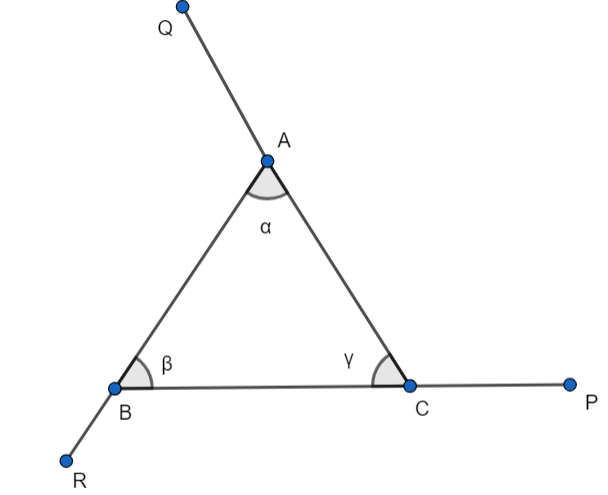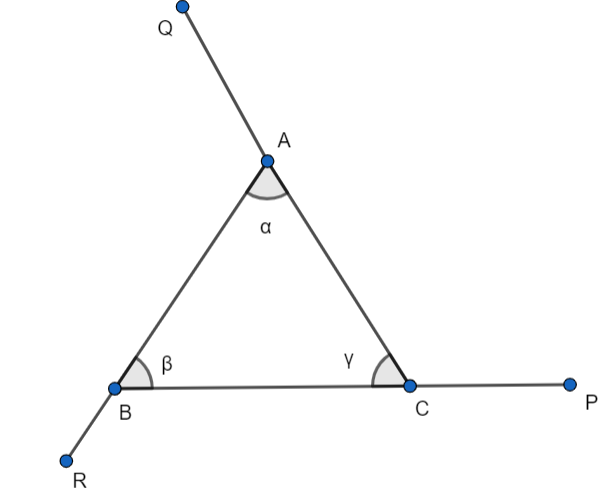
The sum of all exterior angles of a triangle is
A.\[{{360}^{0}}\]
B.\[{{180}^{0}}\]
C.\[{{540}^{0}}\]
D.None of these
Answer
500.4k+ views
Hint: Assume a \[\Delta ABC\] in which \[\angle A=\alpha \] , \[\angle B=\beta \] , and \[\angle C=\gamma \] . We know the property that the measure of an exterior angle of a triangle is equal to the sum of the opposite interior angles. Now, using the property we can say that the exterior angle \[\angle ACP\] is equal to the summation of the angles \[\alpha \] and \[\beta \] , \[\angle BAQ\] is equal to the summation of the angles \[\gamma \] and \[\beta \] , and \[\angle CBR\] is equal to the summation of the angles \[\alpha \] and \[\gamma \] .
Complete step-by-step answer:

Assume a \[\Delta ABC\] in which \[\angle A=\alpha \] , \[\angle B=\beta \] , and \[\angle C=\gamma \] .
For the angles \[\alpha \] and \[\beta \] , \[\angle ACP\] is an exterior angle.
We know the property that the measure of an exterior angle of a triangle is equal to the sum of the opposite interior angles.
Now, using the property we can say that the exterior angle \[\angle ACP\] is equal to the summation of the angles \[\alpha \] and \[\beta \] .
\[\angle ACP=~\alpha +\beta \] …………………(1)
For the angles \[\gamma \] and \[\beta \] , \[\angle BAQ\] is an exterior angle.
We know the property that the measure of an exterior angle of a triangle is equal to the sum of the opposite interior angles.
Now, using the property we can say that the exterior angle \[\angle BAQ\] is equal to the summation of the angles \[\gamma \] and \[\beta \] .
\[\angle BAQ=~\gamma +\beta \] …………………(2)
For the angles \[\alpha \] and \[\gamma \] , \[\angle CBR\] is an exterior angle.
We know the property that the measure of an exterior angle of a triangle is equal to the sum of the opposite interior angles.
Now, using the property we can say that the exterior angle \[\angle CBR\] is equal to the summation of the angles \[\alpha \] and \[\gamma \] .
\[\angle CBR=~\alpha +\gamma \] …………………(3)
For the \[\Delta ABC\] exterior angles are \[\angle CBR\] , \[\angle BAQ\] , and \[\angle ACP\] .
Now, the sum of all exterior angles,
\[~\angle ACP+\angle BAQ+\angle CBR\] ………………………(4)
From equation (1), equation (2), equation (3), and equation (4), we get
\[\begin{align}
& ~\angle ACP+\angle BAQ+\angle CBR \\
& =~\alpha +\beta +~\gamma +\beta +~\alpha +\gamma \\
\end{align}\]
\[=2(\alpha +\beta +\gamma )\] ………………(5)
We know that the sum of all interior angles of a triangle is \[{{180}^{0}}\] .
That is,
\[(\alpha +\beta +\gamma )={{180}^{0}}\] …………………..(6)
From equation (5) and equation (6), we get
\[\begin{align}
& =2(\alpha +\beta +\gamma ) \\
& =2\times {{180}^{0}} \\
& ={{360}^{0}} \\
\end{align}\]
So, the sum of all exterior angles of a triangle is \[{{360}^{0}}\] .
Hence, the correct option is A.
Note: We can also solve this question by using linear pair angles.

Assume a \[\Delta ABC\] in which \[\angle A=\alpha \] , \[\angle B=\beta \] , and \[\angle C=\gamma \] .
Here, \[\angle ACB\] and \[\angle ACP\] are linear pair angles.
So, \[\angle ACB+\angle ACP={{180}^{0}}\]
\[\angle ACP=~{{180}^{0}}-\gamma \] ……………(1)
Here, \[\angle BAQ\] and \[\angle BAC\] are also linear pair angles.
So, \[\angle BAQ+\angle BAC={{180}^{0}}\]
\[\angle BAQ=~{{180}^{0}}-\alpha \] ……………(2)
Here, \[\angle CBR\]and \[\angle CBA\] are linear pair angles.
So, \[\angle CBR+\angle CBA={{180}^{0}}\]
\[\angle CBR=~{{180}^{0}}-\beta \] ……………(3)
From equation (1), equation (2), and equation (3),
\[\begin{align}
& ~\angle ACP+\angle BAQ+\angle CBR \\
& =~~{{180}^{0}}-\gamma +{{180}^{0}}-\alpha +{{180}^{0}}-\beta \\
\end{align}\]
\[={{540}^{0}}-(\alpha +\beta +\gamma )\] ………………….(4)
We know that the sum of all interior angles of a triangle is \[{{180}^{0}}\] .
That is,
\[(\alpha +\beta +\gamma )={{180}^{0}}\] ………………….(5)
From equation (4) and equation (5),
\[\begin{align}
& ={{540}^{0}}-(\alpha +\beta +\gamma ) \\
& ={{540}^{0}}-{{180}^{0}} \\
& ={{360}^{0}} \\
\end{align}\]
So, the sum of all exterior angles of a triangle is \[{{360}^{0}}\] .
Complete step-by-step answer:

Assume a \[\Delta ABC\] in which \[\angle A=\alpha \] , \[\angle B=\beta \] , and \[\angle C=\gamma \] .
For the angles \[\alpha \] and \[\beta \] , \[\angle ACP\] is an exterior angle.
We know the property that the measure of an exterior angle of a triangle is equal to the sum of the opposite interior angles.
Now, using the property we can say that the exterior angle \[\angle ACP\] is equal to the summation of the angles \[\alpha \] and \[\beta \] .
\[\angle ACP=~\alpha +\beta \] …………………(1)
For the angles \[\gamma \] and \[\beta \] , \[\angle BAQ\] is an exterior angle.
We know the property that the measure of an exterior angle of a triangle is equal to the sum of the opposite interior angles.
Now, using the property we can say that the exterior angle \[\angle BAQ\] is equal to the summation of the angles \[\gamma \] and \[\beta \] .
\[\angle BAQ=~\gamma +\beta \] …………………(2)
For the angles \[\alpha \] and \[\gamma \] , \[\angle CBR\] is an exterior angle.
We know the property that the measure of an exterior angle of a triangle is equal to the sum of the opposite interior angles.
Now, using the property we can say that the exterior angle \[\angle CBR\] is equal to the summation of the angles \[\alpha \] and \[\gamma \] .
\[\angle CBR=~\alpha +\gamma \] …………………(3)
For the \[\Delta ABC\] exterior angles are \[\angle CBR\] , \[\angle BAQ\] , and \[\angle ACP\] .
Now, the sum of all exterior angles,
\[~\angle ACP+\angle BAQ+\angle CBR\] ………………………(4)
From equation (1), equation (2), equation (3), and equation (4), we get
\[\begin{align}
& ~\angle ACP+\angle BAQ+\angle CBR \\
& =~\alpha +\beta +~\gamma +\beta +~\alpha +\gamma \\
\end{align}\]
\[=2(\alpha +\beta +\gamma )\] ………………(5)
We know that the sum of all interior angles of a triangle is \[{{180}^{0}}\] .
That is,
\[(\alpha +\beta +\gamma )={{180}^{0}}\] …………………..(6)
From equation (5) and equation (6), we get
\[\begin{align}
& =2(\alpha +\beta +\gamma ) \\
& =2\times {{180}^{0}} \\
& ={{360}^{0}} \\
\end{align}\]
So, the sum of all exterior angles of a triangle is \[{{360}^{0}}\] .
Hence, the correct option is A.
Note: We can also solve this question by using linear pair angles.

Assume a \[\Delta ABC\] in which \[\angle A=\alpha \] , \[\angle B=\beta \] , and \[\angle C=\gamma \] .
Here, \[\angle ACB\] and \[\angle ACP\] are linear pair angles.
So, \[\angle ACB+\angle ACP={{180}^{0}}\]
\[\angle ACP=~{{180}^{0}}-\gamma \] ……………(1)
Here, \[\angle BAQ\] and \[\angle BAC\] are also linear pair angles.
So, \[\angle BAQ+\angle BAC={{180}^{0}}\]
\[\angle BAQ=~{{180}^{0}}-\alpha \] ……………(2)
Here, \[\angle CBR\]and \[\angle CBA\] are linear pair angles.
So, \[\angle CBR+\angle CBA={{180}^{0}}\]
\[\angle CBR=~{{180}^{0}}-\beta \] ……………(3)
From equation (1), equation (2), and equation (3),
\[\begin{align}
& ~\angle ACP+\angle BAQ+\angle CBR \\
& =~~{{180}^{0}}-\gamma +{{180}^{0}}-\alpha +{{180}^{0}}-\beta \\
\end{align}\]
\[={{540}^{0}}-(\alpha +\beta +\gamma )\] ………………….(4)
We know that the sum of all interior angles of a triangle is \[{{180}^{0}}\] .
That is,
\[(\alpha +\beta +\gamma )={{180}^{0}}\] ………………….(5)
From equation (4) and equation (5),
\[\begin{align}
& ={{540}^{0}}-(\alpha +\beta +\gamma ) \\
& ={{540}^{0}}-{{180}^{0}} \\
& ={{360}^{0}} \\
\end{align}\]
So, the sum of all exterior angles of a triangle is \[{{360}^{0}}\] .
Recently Updated Pages
How do you factor x2 + x 20 0 class 9 maths CBSE

How do you solve y6x and 2x+3y20 using substitutio class 9 maths CBSE

Chipko movement originated in Gopeshwar in A 1953 B class 9 biology CBSE

The adjacent sides in the parallelogram are supplementary class 9 maths CBSE

The compound used in plastic industry is A Vinyl acetate class 9 chemistry CBSE

How do you solve for y in 2left y dfrac12 right 4left class 9 maths CBSE

Trending doubts
Write the difference between soap and detergent class 10 chemistry CBSE

When was Shivaji born A 1632 B 1627 C 1678 D 1634 class 10 social science CBSE

a Why did Mendel choose pea plants for his experiments class 10 biology CBSE

For Frost what do fire and ice stand for Here are some class 10 english CBSE

State and explain Ohms law class 10 physics CBSE

What did the military generals do How did their attitude class 10 english CBSE




